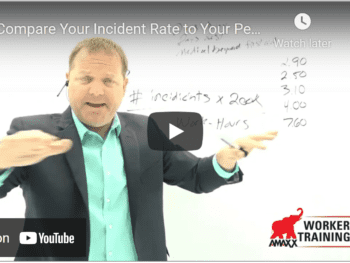In business, things cost money. Lack of return on investment can hinder many executives from thinking outside of the box due to the associated risks. Nothing is a guarantee, and the better businesses are taking smarter risks and reaping the rewards while others maintain the status quo and get passed by like they are going 47 M.P.H. in the fast lane on I-90.
In the claims industry we have several things to point the finger at in order to make our client “Safer and therefore less costly to us since we are paying a ton on their claims.” You can blame their staffing, procedures, lack of a transitional work program, lack of training, and so on. You can really pick a place apart if you wanted to, but the point is that this does not do any good to the executives.
Get To The Root Of The Problem – Example: Patient Lift Technology
Fixing the problem can occur at many levels, but it is most important to get to the root of the problem. If you work at a hospital and notice a trend of back injuries from lifting patients, the solution may not be a staffing issue, but rather a technique issue. However, injuries can occur no matter what the manual technique or the physical fitness of the employee doing the lifting.
Perhaps the cure lies in the manual action of the lifting itself. Nursing homes, therapy clinics, and hospitals have implemented the use of mechanical lifting devices, which bear the brunt of the lifting action. Once you remove the actual “lifting”, you remove the risk of a lifting injury.
Every facility does not have these mechanical devices. The fact is that they can be costly, bulky, and it takes time to hook the patients up to this apparatus, therefore making the job less efficient. Executives may only see the upfront financial cost of having numerous devices in place throughout their facilities and not focus on the end result of less costly work comp back injuries that may require surgical correction. With fewer injuries, staff overtime covering the shifts of injured workers declines, thus leading to more cost savings in the wage category. Those in power look at up-front costs, time wasted on training employees on the use of new equipment, errors and injuries from misuse, and so on.
Even if you have a few of these lifting machines onsite, you still have to make the employees use the device. Employees may see this equipment as a waste of time, skip using them and leave the employer with the same risk they were trying to avoid.
Executives must commit to making the change, implementing the technology, and making sure that the use is considered mandatory across the board. However, who will be in charge of overseeing this new program, tracking the results, and so on? This is not done appropriately most of the time.
Up-Front Costs Present Large Challenge To Change
For whatever reason, this is not a hot-button issue. No matter what the technological implementation, no matter what the occupation of the employer, most executives focus on up-front costs and not back-end long term savings. Some marketer comes in with a new technology that could save thousands upon thousands of dollars, only to be quickly dismissed due to initial costs of implementation.
One problem is that is the executive turns to their carrier to show potential savings, but this is not a number that can be whipped up overnight. Sure you can speculate, but that is not going to cut it for those in power. They want to see real-time right now cost savings, and they want to see it now. Marketers of safety products may use other employers as an analysis, but again this is in a pretend world. It is great that company XYZ saved $250,000 in a 3 year span, but we are not company XYZ, so how can you guarantee that this product will work miracles for me?
I recall a great quote I heard years ago about change.
“One must not leap blindly into change. The most effective way to change a process is to slowly lean in to changing it. Only then will you plant the seeds to creating effective, long-lasting change.”
This is a great point to consider. I do not know of any executive that comes in one morning and radically overhauls an entire way of doing business. Rather they pick apart the process and attack in small increments, one at a time. For example, if you work in an assembly-line type of factory, maybe the best change to slowing down repetitive motion injuries is to change one thing at a time. Change the chairs. Then you change the work stations so they can be adjusted by height custom to the worker using the station. Then later on you change the way the tools are handled and used. If you spread this process out over the course of a year, you also spread out the cost of the implementation, instead of taking the financial hit within one fiscal quarter.
Implement Changes One Step At A Time
Once your changes are implemented, and a number of months have gone by, then you can look at the injury cost savings. Were there fewer injuries reported over the last year than in prior years? Less lost time from work means less overtime and stress placed on other workers which could have led to more injuries outright. Has worker efficiency increased? Are workers satisfied with the changes and being proactive in voicing more opinions on further changes that could be implemented? If the answers to all of these questions are positive, then you have made a lasting impact on the overall safety at your plant. And you did so by doing it the smart way—by not bombarding your workers with an entirely new way of doing business. You leaned into the change, corrected one thing at a time, and provided some flex time for your workers to get used to the new process.
We are not reinventing the wheel here, but you would be amazed at how often executives fail at this process. The bottom line is to promote positive return on investment in technology by going about it the right way. Any loss prevention professional will tell you that it is not going to happen overnight. You have to pick your battles, correct the problems, and have proactive follow-up and tracking of logistics and metrics to show improvements. This battle to become a safer work environment is constantly ongoing, and if your battle plan is to just ignore it and plow forward, then you will fail to change.
Author Michael B. Stack, CPA, Director of Operations, Amaxx Risk Solutions, Inc. is an expert in employer communication systems and part of the Amaxx team helping companies reduce their workers compensation costs by 20% to 50%. He is a writer, speaker, and website publisher. www.reduceyourworkerscomp.com. Contact: mstack@reduceyourworkerscomp.com.
©2013 Amaxx Risk Solutions, Inc. All rights reserved under International Copyright Law.















